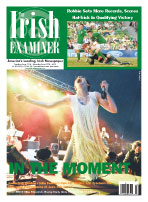Northern Population Grows With Nearly 6,000 New Migrants
Population migration therefore added 5,700 residents to the Northern population; this is significantly lower than the 9,000 residents added through migration in both 2005-6 and 2006-7.
The Northern Ireland Statistics and Research Agency (NISRA) has this week published detailed figures on population migration to and from the North.
In total 27,500 people came to live in the North in the year to June 2008 and 21,700 people left to live elsewhere.
Population migration therefore added 5,700 residents to the Northern population; this is significantly lower than the 9,000 residents added through migration in both 2005-6 and 2006-7.
This recent fall is related to less people coming to live in the North from outside the UK.
NISRA published a detailed migration report "Long-term International Migration Estimates for Northern Ireland (2007-8)" which examines these new migration figures in detail.
Among some of the key points are:
- after a long period through the 1970s and 1980s of emigration from the North exceeding immigration, and a period of balanced migration flows during the 1990s, the recent period since 2004 has seen significant population growth due to migration;
- migrants from the expanded European Union are the main source of increased migration. Most people from the new EU states coming to the North to work must register with the Home Office Worker Registration Scheme (WRS). The WRS shows that, in the year to June 2008, some 7,800 people registered to work in the North, compared to 9,100 people in the year to June 2007. The latest figures from the WRS suggest that these figures are slowing further (4,800 WRS registrations in the year to March 2009);
- by number, Polish migrants are the largest group of migrants from the new EU states, accounting for nearly 60% of such migrants;
- new registrations with family doctors from migrants coming from outside the UK have fallen from 19,400 registrations in 2007 to 15,400 in 2008, more than half of which were migrants. Over half those registering with doctors gave their reason for coming here as work related, while 27% came for family reasons, 9% for education and 10% gave another or no specific reason.
- 2,300 births in the North (9% of all births) were to mothers born outside the UK and Ireland, compared to 700 such births (3% of all births) in 2001. Of these, 1,100 births in 2008 were to mothers from the new EU states, compared to 10 such births in 2001. Indications are that in 2009 births to mothers born outside the UK and Ireland will be at a similar level to that seen in 2008;
- the School Census from 2008 shows that about 4,300 primary school children have a language other than English as their 'first' language. This is nearly 2% of the primary school population, and an increase on the corresponding figure (3,500) for 2007. For secondary school children, the increase has been from 1,700 pupils to 2,100 pupils (1% of the secondary school population);
- overall migration trends vary across the North. Flows around areas such as Botanic (Belfast), Jordanstown (Newtownabbey) and Strand (Derry) are driven by students. Information from registrations with family doctors shows that in parts of Belfast, Craigavon and Dungannon, annual immigration flows in 2008 exceed 1 in 20 of the resident population.
|













